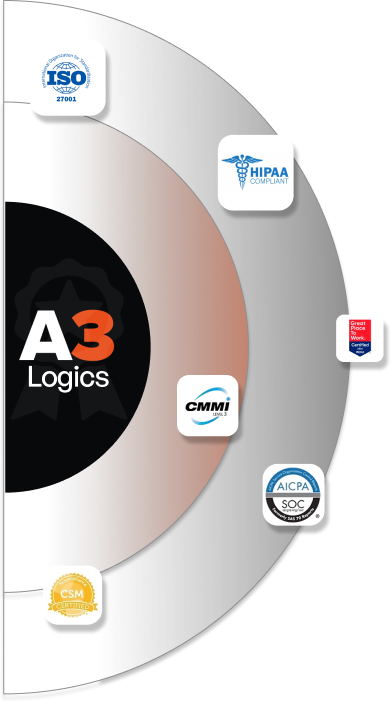Cloud security in software development protects data, applications, and infrastructure in cloud computing. It uses various methods, technologies, and rules to keep cloud systems safe. In secure software development, cloud security is crucial to protect against dangers affecting data safety, availability, and secrecy.
The growth of cloud security in software development has been significant. It started by focusing on defending the outer limits and preventing unapproved access. As threats grew more complex, the approach changed. Security became a part of every step in the secure software development lifecycle. Developers started using DevSecOps, which adds security to the DevOps process. This change led to proactive, continuous security actions and instant threat handling.
{{Content for Infographic}}
In 2025, cloud security in software development has evolved further with more use of cloud services and complex cyber threats. A Gartner report expects a big move to cloud-first methods by 2025, with 85% of companies following this path. This highlights the importance of solid cloud security.
Artificial Intelligence (AI) and Machine Learning (ML) now play a big part in cloud security. They assist in predicting and automatically detecting threats. Strong regulations also focus on cloud security for following rules and safeguarding customer information.
In conclusion, the 2025 scenario of cloud security in software development includes advanced tech, a shift to cloud-first approaches, and a keen focus on following rules and protecting data. As dependence on cloud computing grows, effective cloud security measures to protect the secure software development lifecycle become more crucial.
Table of Contents
What are the Importance of Secure Software Development Practices in 2025?
Secure software development has become crucial in 2025. Given the increase in cyber threats and sophisticated attacks, it’s not merely a bonus; it’s necessary. A report by Cybersecurity Ventures suggested that cybercrime expenses were projected to hit an astonishing $6 trillion annually by 2021 and $10.5 trillion by 2025, with expectations of further increase. This underscores the pressing demand for secure software development methods.
For custom software development companies in USA and worldwide, security is an integral aspect of software creation. It has transcended beyond being a mere additional element.
Security violations severely affect businesses. They result in monetary losses, tarnish brand reputation, and diminish consumer confidence. According to IBM’s 2023 study, an average data breach incurs costs of about $4.45 million. For software developers, a breach implies more than financial detriment; it risks destroying their reputation and the trust placed in them by their clients.”
Benefits of Secure Practices in the Cloud Era
Secure software development is vital in the cloud era. A secure software development framework is essential as businesses move to the cloud.
One major benefit is data protection. Secure practices protect data from unauthorized access and breaches, which is important under laws like GDPR and CCPA.
Another benefit is better business continuity. Secure practices find and fix vulnerabilities early, reducing disruption from security incidents. This proactive security saves costs and keeps businesses running smoothly.
In conclusion, software development practices in 2025 are vital. The need for security, the effects of breaches, and the benefits of secure practices in the cloud era all show the importance of security in the software development lifecycle. As digital threats grow, so must our focus on secure software development.
Looking for a Tech Upgrade? Let’s Build Your Next Software Solution Together!
Top 9 Proven Cloud Security Practices for Secure Software Development
1. Implementing Strong Access Control
Controlling access is key in secure software development, especially for custom software development consulting. Use multi-factor authentication and strict rules to keep unauthorized users out. Role-based access control (RBAC) lets people access only what they need for their jobs, reducing data breach risks. Regular checks of these controls keep security tight, even when roles or jobs change.
2. Ensuring Data Encryption
Encrypting data, both stored and in transit, is essential. It keeps data safe even if intercepted, which is crucial for healthcare digital transformation companies concerned with patient privacy. Using end-to-end encryption for data in transit adds an extra security layer against interception and attacks.
3. Regular Security Patching
Keeping software up to date is critical to protect against known threats. This is a basic but vital practice in secure software development best practices. Keeping track of all software and hardware helps manage updates, preventing any part from becoming a security risk.
4. Secure Coding Practices
Writing code securely is important. It means avoiding errors that create vulnerabilities, like SQL injection. Secure coding is key for businesses looking to hire software developers, ensuring software safety from the start. Regular code reviews and automated vulnerability detection reduce security flaw risks. Training developers in these practices build a security-aware team.
5. Utilizing Identity and Access Management (IAM)
IAM systems manage who gets access to what. This is especially crucial in sectors like banking, where secure identity management is a must. They enforce strong authentication and ensure access follows the ‘least privilege’ principle. Regularly updating IAM policies to meet new threats is vital. Linking IAM with other security systems gives a complete view of security and user actions.
6. Incorporating Threat Intelligence
Understanding potential threats is crucial. Using threat intelligence helps prepare for and prevent attacks, which is key in a constantly changing threat environment. Working with external intelligence sources gives a wider threat view. Putting this intelligence into security systems allows for proactive defense, improving threat anticipation and response.
7. Adopting a Zero Trust Architecture
Zero Trust Architecture means not trusting anyone by default, either inside or outside the organization. Verify everything that tries to connect to your system. This approach is increasingly important in the cloud era. Strict identity checks and limited access are core to this approach. Keeping these controls updated and monitored is crucial for dealing with new threats.
8. Continuous Monitoring and Logging
Constant monitoring of network and system activities is essential for detecting security issues. This is an important part of a strong security strategy, especially for businesses in digital transformation. Combining logging with real-time analysis and alert systems, like SIEM, is key, especially for businesses evolving digitally.
9. Disaster Recovery and Business Continuity Planning
Being prepared for security incidents is crucial. This includes having plans to quickly restore data and maintain key operations, particularly important in sectors like healthcare. Regular plan testing and updates ensure real-world effectiveness. Business continuity planning keeps essential functions during and after incidents, reducing downtime and safeguarding reputation.
In conclusion, these nine cloud security practices are vital for secure software development in 2025. They cover various strategies to protect digital assets and keep data safe. As technology advances, these practices will remain important for all sectors, from healthcare to businesses hiring software developers for custom projects.
What are the Importance of Robust Authentication Mechanisms in the Cloud?
Authentication is key in cloud computing security. It checks if users are who they claim to be. Strong authentication is vital in secure software development, especially for custom software development outsourcing and startups. It’s more than data protection; it’s about trust in a growing world of threats.
The cloud, easily accessed, faces unique security challenges. Unauthorized access can cause data breaches, loss of trust, and big financial harm.
{{Content for Infographic}}
Types of Authentication Mechanisms
There are various authentication methods, each with pros and fit for different situations:
- Password-Based Authentication: Uses usernames and passwords. Simple but vulnerable to attacks like phishing.
- Token-Based Authentication: After logging in, a system generates a token for later checks. More secure than passwords, common in web apps.
- Biometric Authentication: Relies on unique body traits, like fingerprints or facial recognition. Very secure and growing in popularity.
- Certificate-Based Authentication: Uses digital certificates with public key infrastructure (PKI). Offers high security, often in business environments.
Role of Multi-Factor Authentication (MFA)
MFA enhances cloud security. It asks for several identity proofs before access, cutting down unauthorized access risks. MFA combines a known password, a possessed item like a phone, and a personal trait like a fingerprint.
MFA is crucial for custom software development for startups. With limited security resources, startups can’t afford breaches. MFA adds extra security, making it tougher for attackers even if they crack one security layer.
In conclusion, strong authentication is vital for secure software development in the cloud. It’s the first defense against unauthorized access, keeping sensitive data safe. As cloud computing evolves, effective authentication becomes more critical and essential for any firm in custom software development outsourcing or startups.
Empower Your Business with Cutting-Edge Software. Request a Free Consultation Today!
How can encryption protocols protect Data in the Cloud?
Encryption is key in cloud security, turning readable data into a secure format. This means if data is taken or accessed wrongly, it stays safe and unreadable.
In secure software development, encryption is crucial. It keeps data safe from threats and maintains privacy and compliance. This is vital in healthcare, where digital transformation needs strict patient data privacy. Encryption acts like a shield in the cloud, keeping data safe from unauthorized access.
Types of Encryption Protocols
There are different encryption protocols for different needs:
- Symmetric Encryption: Uses one key for both locking and unlocking data. It’s quick and good for large data, but managing the key can be tough.
- Asymmetric Encryption: Uses two keys – a public lock and a private one to unlock. It’s very secure and often used for internet communication.
- Hash Functions: These aren’t traditional encryption but are important for keeping data unchanged. They change the data into a fixed hash value, showing if it is altered.
- Transport Layer Security (TLS): Essential for safe internet data transfer. It’s common in web apps to keep client-server communication secure.
Implementing Encryption in Software Development
For custom software development services, using encryption involves several best practices:
- Always Encrypt by Default: Always lock sensitive data, whether stored or sent. This reduces the chance of it being seen by others.
- Strong Key Management: Use good key management, like safe key storage, changing keys often, and using strong key creation methods.
- Integrate Encryption Early: Add encryption early in the software development process. This makes security a built-in part of the app.
- Regularly Update Encryption Protocols: Keep up with new encryption methods. As tech changes, so do ways to break encryption. Updating keeps your encryption strong.
- Follow Compliance and Standards: Ensure your encryption follows rules and standards, especially in healthcare. For example, in digital transformation in healthcare, following HIPAA rules for patient data is key.
Encryption protocols are vital in cloud security and secure software development. They protect data from unauthorized access and help meet regulatory standards. As cloud technology grows, using strong encryption protocols is a top priority for many sectors, from custom software development services to healthcare digital transformation.
What is the Importance of Regular Security Audits and Monitoring in Cloud-Based Software Development?
Security audits are vital in cloud-based software development. They thoroughly check a system’s or application’s security. This is key to finding weak spots and ensuring security measures work well. Regular audits in secure software development keep defenses strong against new cyber threats.
Audits typically look at security policies, network and system setups, and compliance with relevant rules. For businesses using digital transformation services, these audits make sure new tech and processes are secure.
Best Practices for Effective Monitoring
Good monitoring is more than just tools. It’s about using them right. Monitor network traffic, user actions, and system logs to spot potential security issues quickly. This proactive step is crucial for keeping cloud-based applications safe and intact.
Important monitoring practices include:
- Real-Time Monitoring: Use tools that spot unusual activities right away. This lets you respond fast to possible threats.
- Regular System Checks: Regularly check that all security measures work as they should.
- User Activity Monitoring: Watch what users, especially those with access to sensitive data, are doing. This helps catch unauthorized access or strange behavior.
- Integration with Development Processes: Blend monitoring tools with the development process. This is especially important in DevOps, which rely on continuous integration and deployment.
Tools and Techniques for Audits and Monitoring
Key tools and methods for doing security audits and monitoring in cloud-based software development include:
- Automated Security Scanning Tools: Tools like Nessus or Qualys automate system scans for weak spots.
- Intrusion Detection Systems (IDS): IDS tools detect unauthorized access or network traffic anomalies.
- Security Information and Event Management (SIEM): SIEM systems combine and analyze security logs from different sources, giving a full view of the security situation.
In conclusion, regular security audits and monitoring are crucial in secure software development, especially for cloud-based setups. They’re an essential defense layer, helping to find and reduce potential security risks. Advanced tools like AI will make these practices even more effective as technology evolves. This ensures businesses can confidently face the digital era’s challenges.
Ready to Build? Let’s Create Your Software Solution Today!
What are The Cloud Security Challenges in Software Development?
In secure software development, cloud security has unique challenges. Enterprises and healthcare software development companies face these when they move to the cloud. A big issue is data breaches.
Cloud services also risk cyber-attacks because they hold a lot of data. A common problem is when cloud settings are wrong, leading to unwanted access and data leaks.
Compliance and Regulations
For enterprise software development companies, following rules and regulations in cloud security is tough. Different industries have different rules, like HIPAA for healthcare and GDPR for data protection in Europe. Making sure cloud services follow these rules is key but complicated.
The challenge is the ever-changing cloud technology and laws. Companies need to keep their compliance strategies updated. Not doing so can lead to big fines and loss of trust.
Balancing Security and Ease of Use
A major challenge in cloud security is keeping things secure while easy to use. Security is important, but it shouldn’t make things hard. If security is too complicated, it can slow down work and annoy users.
For example, enterprise software development companies must ensure their security doesn’t make their software slow. Healthcare software development companies must keep patient data safe but easily accessible to the right people.
To sum up, cloud security challenges in software development include data breach protection, compliance with laws, and keeping security user-friendly. Solving these issues means staying current with security trends, knowing the laws, and making security help, not hinder the user experience.
How to Select The Best Software Development Company for Your Project?
Picking the right software development company is key to your project’s success. First, know your needs. Do you need a fintech software development company or another expertise? Understanding this helps. Consider these points next:
- Technical Skills and Focus: Find a company with strong skills in your project’s needed areas. A focus on a field like fintech is beneficial.
- Experience and Proven Success: Check the company’s history with projects like yours. Quality delivery in the past shows their ability.
- Development Approach: Their process should fit your project. Agile methods are often chosen for being adaptable and efficient.
- Communication and Teamwork: Good communication is vital. Opt for a company that values clear, open interactions.
The Need for Security Skills
In our digital world, especially in fintech, security is crucial. Pick a company with solid skills in secure software development. Poor software security can cause huge financial and reputation losses.
A skilled company will weave security into every software development stage. They should be up-to-date with security trends and rules, especially in regulated finance-related industries.
Reviewing Past Work and Client Feedback
To judge a software development company’s skills and reliability, look at their past work and client feedback.
- Portfolio Check: Their portfolio shows the types and complexity of their past projects. It also reflects their design and development skills.
- Client Opinions and Reviews: Customer feedback gives insights into working with the company. Independent review sites offer unbiased views.
- Case Studies: These show how the company tackled specific problems and their solutions. They are useful for seeing their problem-solving and innovation abilities.
In summary, choosing the best software development company involves looking at technical skills, security knowledge, and a solid history. In areas like fintech, where security is critical, a company adept in secure software development is vital. You can decide wisely by evaluating companies against these points, matching your project’s goals and needs.
Evaluating Cloud Service Providers for Secure Software Development
Selecting the right cloud service provider is crucial in safe software creation. The provider you choose greatly impacts your project’s safety, efficiency, and success. Consider these factors:
- Security Tools: Look for providers with top security tools, like firewalls, intrusion detection, and encryption. These tools are key to protecting your cloud data and apps.
- Meeting Standards: Make sure the provider meets specific industry standards. This is very important in healthcare or finance with strict data rules.
- Consistent Service: Go for providers known for steady and reliable service. This helps keep your work on track and meet deadlines.
- Growth Support: Your provider should offer solutions that can expand your business. Being able to adapt to changing software needs is important.
- Customer Help and Care: Strong customer support and regular service care are necessary. Look for providers offering quick help and frequent updates.
- Easy Integration: The cloud services should fit well with your current tools and work methods. This helps keep your software work smooth and efficient.
Why Provider’s Security Methods Matter in Development
The security methods a cloud service provider uses are vital for the safety of your software work. They protect your apps and data from risks. Here’s why they’re important:
- Data Safety: Good security protects sensitive data from unwanted access and leaks. This is critical for keeping your data private and whole.
- Following Rules: Sticking to these security methods helps you follow data safety laws. This keeps you away from legal issues and protects your reputation.
- Trust and Dependability: Providers with strong security are more reliable. This builds trust with your partners and customers.
- Using New Tech: Security-focused providers may use new tech, like artificial intelligence in software development, for better safety. AI can predict and automatically handle threats.
- Handling Risks: Effective security methods help spot and lessen security risks before they grow.
Consider these points, especially security methods, when choosing cloud service providers for safe software work. The right provider helps with your current needs and fits your long-term safety and business plans. In safe software creation, your cloud service provider’s choice greatly influences your project’s success and protection.
Integrating Cloud Security with DevOps Practices
Secure software development gets a big boost when cloud security joins hands with DevOps, especially through DevSecOps. This approach, short for Development, Security, and Operations, brings security into the DevOps flow. Here’s why it’s important:
{{Content for Infographic}}
- Catching Issues Early: With DevSecOps, teams spot and tackle security problems early in software making. This early action is way better than fixing issues after the software is built.
- Security All the Way: DevSecOps keeps security in mind at every step of software creation. It’s not just an afterthought but a key part of the whole process, from start to finish.
- Automating for Safety: A big part of DevSecOps is using automation for security tasks. This constant security check reduces errors and lets developers focus more on creating great software.
- Working Together: DevSecOps is about developers, security folks, and operations teams working in harmony. It’s all about everyone understanding and valuing security’s role.
- Staying Compliant and Managing Risks: DevSecOps includes regulatory standards from the start. This approach helps handle risks better and ensures software meets all the rules.
Integrating Security in Continuous Workflows
Here are some key ways to include security in continuous integration and deployment:
- Embed Security in Workflows: Bring in tools that scan for risks in code and deployments as part of your regular workflow.
- Teach Developers About Security: Regular training sessions on the latest security practices help developers keep security at the forefront of their work.
- Review Code Regularly: Use tools to check code and have team members review each other’s work for security issues.
- Keep Different Work Areas: Separate spaces for development, testing, and live deployment help prevent accidental issues in the final product.
- Watch and Act Fast: Always monitor your applications for security threats and be ready to respond swiftly to any problems.
In short, combining cloud security with DevOps through DevSecOps is crucial for creating safe software. It ensures security is an ever-present element in software development, leading to safer and more reliable products. This integration becomes even more essential for any organization committed to developing secure, high-quality software as technology evolves.
Legal and Ethical Considerations in Cloud-Based Software Development
Knowing and following data rules and compliance is vital in secure software development, especially with cloud-based systems. Data sovereignty means that data follows the laws of the country where it’s stored. This gets tricky in cloud setups, where data may be in many countries.
- Dealing with Various Laws: Developers must understand the legal side of where their cloud data lives. Different countries have different rules about data access and privacy. For example, GDPR sets strict privacy and protection standards in the European Union.
- Sticking to Laws Everywhere: Compliance means following the laws where the software is made and used. This includes GDPR in Europe for privacy, HIPAA in the U.S. for health data, and other national laws.
- Agreements with Cloud Providers: Clear contracts with cloud providers are key. These should cover how data is handled, stored, and processed to meet legal requirements.
Ethical Side of Data Security in Software Making
Beyond legal needs, ethical issues also matter in cloud-based software making. This is about the moral duty to protect user data and respect privacy.
- Duty to Safeguard User Data: Developers should use strong security, like encryption and access controls, to prevent unauthorized access to user data. Regular security checks are also important.
- Being Clear with Users: Being open about their data is ethical. Tell them how their data is used, kept safe, and stored.
- Not Misusing Data: It’s also about not using user data in harmful ways or beyond what users agreed to. This means not selling or sharing data without clear user permission.
- Fairness in Using Data: Ethical practices also mean ensuring data use doesn’t discriminate or bias against certain user groups. This is crucial in fields like AI and machine learning, where biased data can lead to unfair results.
In summary, legal and ethical parts of cloud-based software development are key to making secure software. They’re about following data laws and upholding ethical standards for protecting user data and privacy. As cloud computing grows, these issues get more complex and important, demanding continuous focus from developers and companies.
Future Trends in Cloud Security Technologies
The cloud security field is changing fast, driven by new tech. Looking ahead, several new technologies will shape cloud security in secure software development. Businesses and developers need to know these to stay ahead of security threats.
- AI and Machine Learning: AI and ML are changing cloud security. They offer advanced threat detection and responses. These techs can quickly and accurately find security risks by analyzing huge data sets.
- Quantum Computing: Still developing, quantum computing is a double-edged sword for cloud security. Its power might break current security encryptions and create super-secure encryption methods.
- Blockchain Tech: Known for cryptocurrencies, blockchain is also impacting cloud security. Its secure, transparent, and unchangeable record-keeping reduces fraud and data tampering risks.
- Edge Computing: With computing happening closer to where data is created, edge computing means faster processing and less delay. But it also requires new ways to keep data safe over a wider network.
- Zero Trust Security Models: The ‘never trust, always verify’ approach is key in cloud security. Zero trust means strict checks on everyone and every device trying to access network resources.
Getting Ready for Future Security Hurdles in Software Making
As these new technologies grow, those in secure software development must prepare for future security challenges:
- Ongoing Learning and Adapting: Professionals must keep learning to stay updated with fast-changing tech. Knowing the latest security trends and tech is crucial.
- Investing in Advanced Security Tools: Companies should invest in sophisticated security tools. Tools powered by AI and ML are especially important for predicting and understanding threats.
- Working Together More: Security isn’t just an IT thing anymore. It needs cooperation across all departments. Sharing knowledge and best practices is essential to face future security challenges.
- Being Proactive About Security: It’s better to be proactive than reactive in security. This means considering security from the start of software development and keeping it in mind at all stages.
- Ethical Issues: With advanced tech like AI growing, ethical issues in software development are more important. Developers and companies must use these techs responsibly and protect user privacy and rights.
In conclusion, the future of cloud security in software development is exciting but also full of challenges. Developers and businesses can keep their cloud environments safe by staying up-to-date with new technologies and preparing for new security issues. Embracing these innovations is not just about security; it’s about building a safer, more efficient future in software development.
Transform Your Software Vision into Reality – Book A 30 Minutes Free Consultation!
Conclusion
As we conclude our look at cloud security in software making, let’s remember the main points. Secure software development isn’t just a trend; it’s essential in our digital age. Including strong security steps in the software creation process is key to protecting important data and keeping trust in tech.
We’ve discussed the need for strong login methods, the role of encryption, and the importance of regular security checks and monitoring. These are the core of a safe cloud space. Also, we’ve learned that keeping security user-friendly is important for making secure yet easy-to-use apps.
Looking forward, the future of cloud security in making software is both a challenge and full of potential. As online threats change, our security methods must also evolve. We’ll likely see more advanced security, like using AI and machine learning to predict and respond to threats.
The ongoing digital change in different industries will keep pushing the need for secure software-making practices. Companies will keep innovating, creating better security solutions to face a constantly changing threat world.
In closing, the path to secure software making is always moving. It needs ongoing work, watchfulness, and adapting to new challenges. As we go forward, we must keep security as a main focus in our digital projects. Remember, the safety and wholeness of our digital world depend on it.
Are you ready to boost your cloud security? Start moving towards a safer future in secure software development with A3Logics. Let’s join forces to make safer digital tools for the future.
Unlock Answers, Tackle Doubts: Your FAQ Handbook!
1. What’s Most Important for Cloud Security in Software Development?
The key to cloud security for secure software development is weaving security into every stage of the software development lifecycle (SDLC). This means security isn’t just tacked on at the end but is part of the process from the beginning – design, development, testing, deployment, and upkeep.
2. How Often Should We Do Security Audits in Cloud Settings?
Security audits in cloud settings should be regular. The frequency depends on how sensitive the data is and the system’s complexity. Generally, yearly audits are good, but doing it quarterly or every six months is better for handling sensitive data or rapidly changing environments.
3. Top Tips for Data Encryption in the Cloud?
For encrypting data in the cloud:
- Encrypt stored data and transferred data using strong protocols like AES and TLS.
- Manage encryption keys well, with secure storage, frequent changes, and strong creation methods.
- Use end-to-end encryption, ensuring data is encrypted from origin to destination.
4. How Does Multi-Factor Authentication Boost Cloud Security?
Multi-factor authentication (MFA) strengthens cloud security by adding extra security layers beyond just a password. It requires multiple identity proofs, like a physical token, a fingerprint, or a code sent to a phone. This makes it much harder for unauthorized access, as it’s more difficult to compromise several security methods than just one.
5. Common Cloud Security Errors Companies Make?
Companies often slip up in cloud security by:
- Not limiting access to sensitive data enough.
- Skipping regular security checks to find and fix weak spots.
- Not training employees properly in security practices.
- Ignoring specific industry rules and compliance needs.




